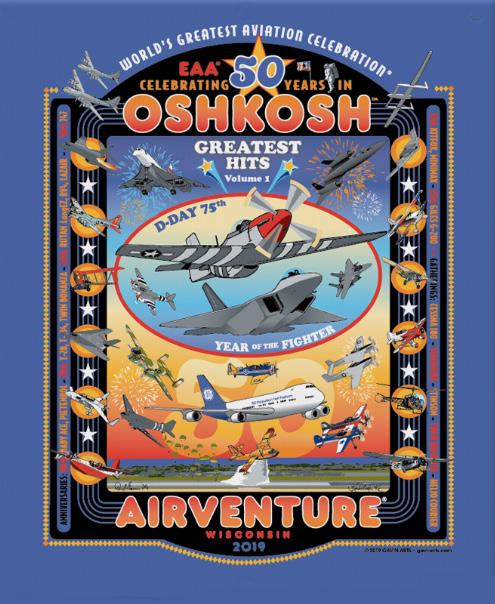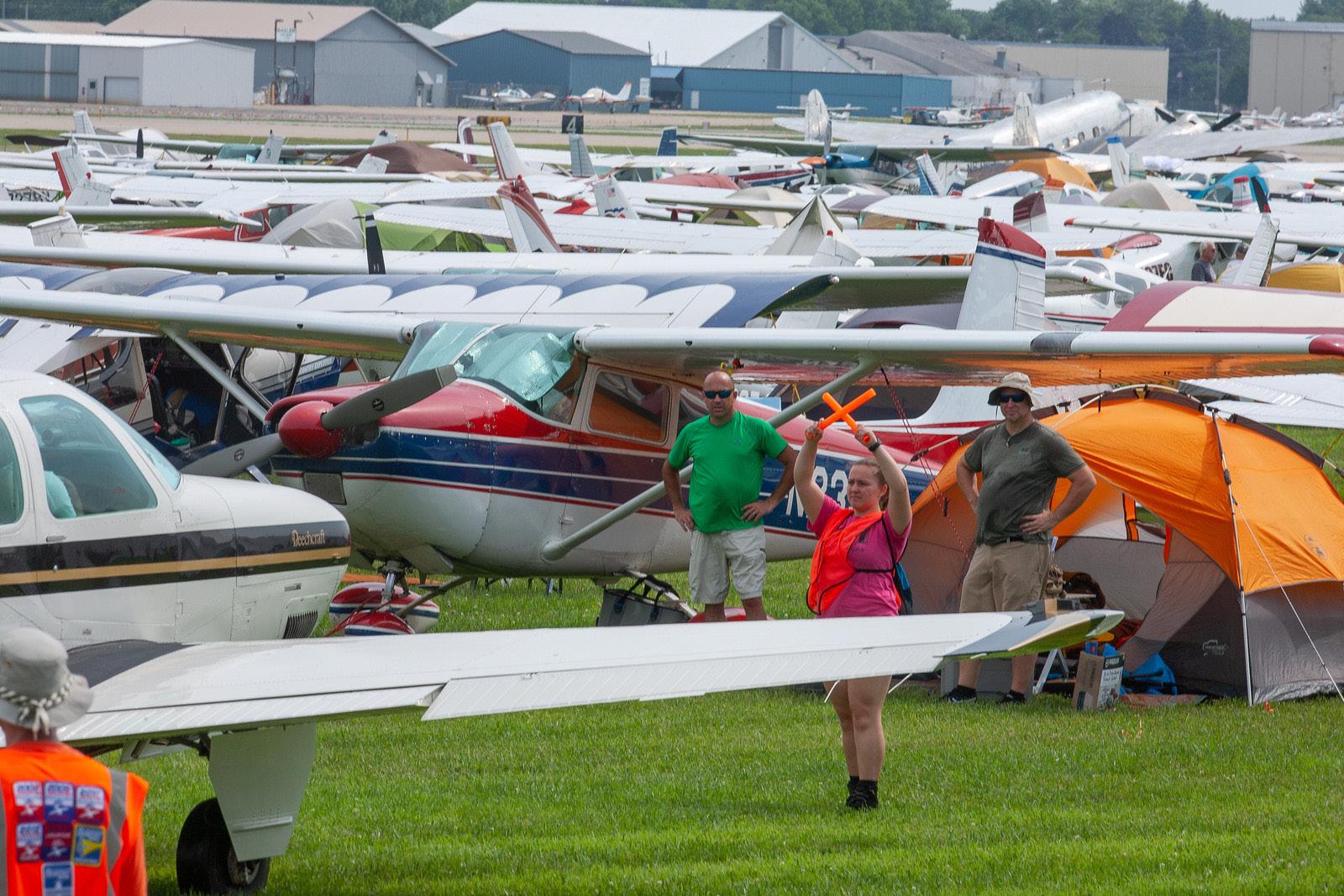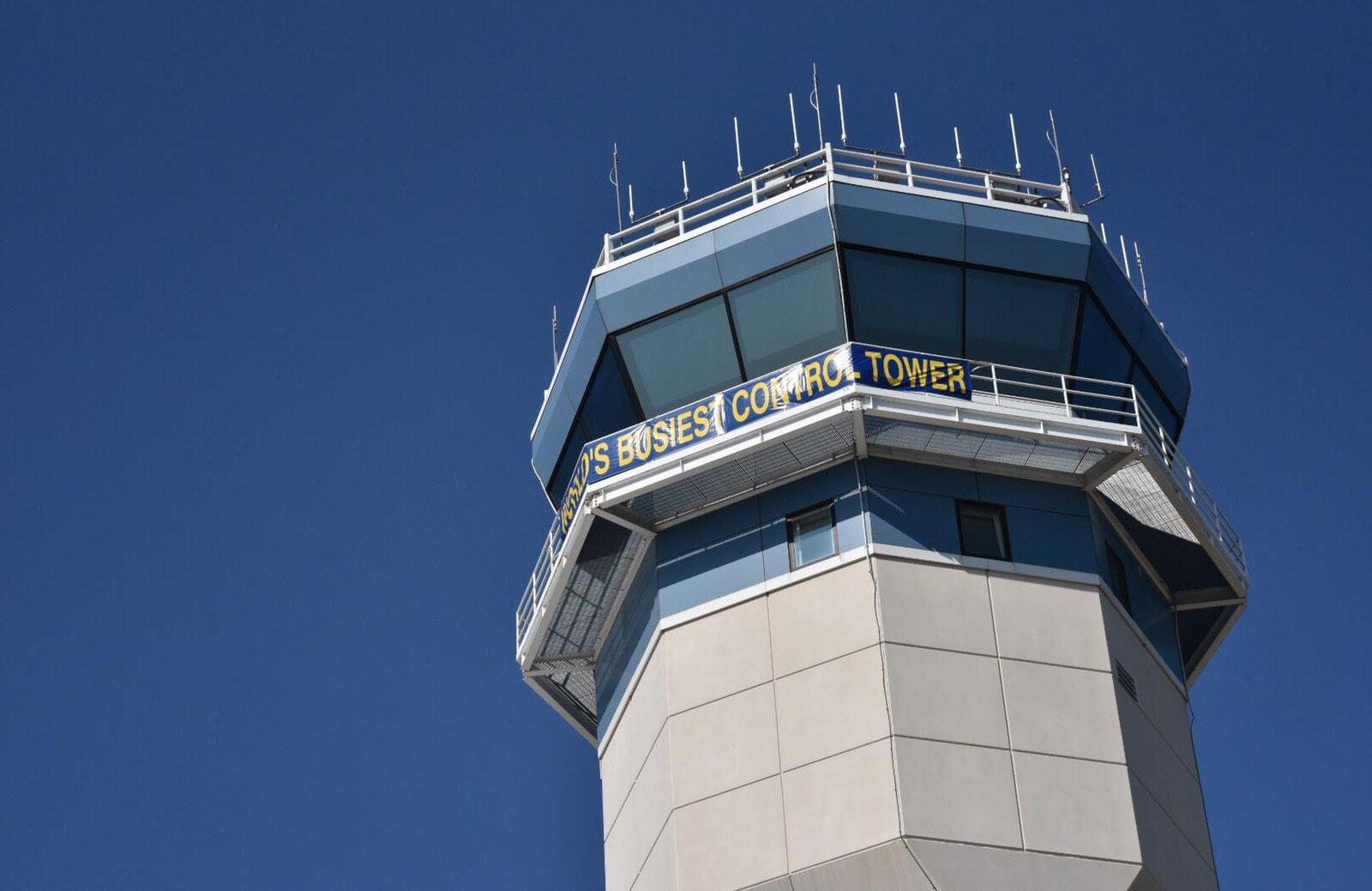
11 minute read
News from Oshkosh AirVenture 2019
zby Philippe Domogala, SENIOR CORRESPONDENT, IFATCA ATC THE OSHKOSH AIRVENTURE WAY
Eric and I decided to fly again to AirVenture Oshkosh, this year for the whole week. We departed from Quebec in his Cutlass II (an upgraded Cessna 172 with retractable gear and a variable pitch prop). We planned to arrive on the Saturday to avoid the bigger Sunday crowds. Our plans were first upset by an unfortunate, new U.S. immigration policy. Since our last visit 2 years ago, it is no longer possible to have immigration done at the first airfield of arrival in the USA. You must now physically land at a border crossing point to have your passport checked, an entry card filled up, stamped and stapled in your passport. We had to land on the Canadian side of the border at the Sault Ste. Marie Airport (CYAM), rent a car, drive to the bridge, get the immigration processed. The friendly border guard shook his head in disbelief regarding the procedure. But hey, we all have to follow the new rules. Right? We had to pay US$6 for the stamp and drive back to the airfield. When we returned, thunderstorms were starting to come up. Looking at the weather en route, it was now very doubtful that we could make it that day. We decided to spend the night in Sault Ste. Marie and take off very early the next morning. We decided to depart, so we would arrive at the earliest time possible in the U.S. airfield for the real customs and immigration. We got up at 3:00 a.m. for a 05:00 a.m. departure. We landed at Sanderson Field (KANJ) just across the border at 5:15 a.m. to refuel. We took off at 6:00 a.m. and planned for an arrival in Oshkosh at 7:00 a.m. just as OSH opens to avoid the Sunday rush. It is a twohour flight, but there is one-hour time difference between Michigan and Wisconsin. All went according to plan until 10 nautical miles before reaching Ripon, the mandatory entry point for VFR to OSH. We were in contact with Green Bay approach, who asked us if we have a permit for Tarmac parking or planned to park on the grass. We had planned for grass parking and camping. We then were told the airfield is closed for grass parking, as it had rained too much the night before, so everything was soaked. The first two aircraft that landed there some minutes before got stuck in the mud! We quickly diverted. Appleton International Airport (KATW) is the closest option. We got a clearance for it, and 10 minutes later, we landed on this large airport, along with hundreds of other diverted aircraft. We were then told the Oshkosh Airfield is closed because of the rain. We contacted the NATCA controllers at OSH who said they will send us an SMS when the field would reopen, so we could perhaps get a small time advantage ahead of the later rush. AirVenture is an annual gathering of aviation enthusiasts held each year in Oshkosh, Wisconsin, in the United States. The air show is arranged by the Experimental Aircraft Association (EAA), an international organization based in Oshkosh, and is the largest of its kind in the world. AirVenture lasts a week each year, and during the gathering, the airport's control tower is the busiest in the world.
Advertisement
Later in the afternoon, we received word that the field would reopen at 4:30 p.m., but only remain open until 8:00 p.m. We rushed to our aircraft and were the third aircraft to taxi out. Things were looking good! A few hundred aircraft had been parked all over the airfield because of the diversions. Soon, dozens of other aircraft, which also had heard the news, started to taxi from everywhere. The ground controller became overwhelmed. It was a mess, and nothing moved. The tower controller took over and called aircraft by type and colour instead of call signs and managed to create order and let us depart. With this delay, we lost 45 precious minutes stuck on a taxiway!
When we finally took off, the sky was filled with aircraft heading toward Oshkosh, not only from Appleton. And everyone was converging on Ripon! The NOTAM was clear, everyone had to start from there, separate from others by about one nautical mile at 1,800 feet at 90 knots with gear down and all landing lights on (or 2,300 feet at 135 knots, if unable to maintain 90 knots). This is all fine on paper, but a bit more difficult when you are flying. You first get to a lake, called Green Lake (although, it is dark blue) at 3,000 feet. You hold around it to find a spot between two others doing the same, descend to their altitude, reduce speed, and maintain that distance.
The problem was locating the other aircrafts flying beside and in front of you. Measuring one nautical mile in the air is also not so easy. Eric spotted two aircraft. We followed them, and it looked like there is a spot in between them. But no, there already is another one just besides us, so we started again. We found the right spot this time and followed a guy in front that now is constantly reducing speed. To avoid overtaking this plane, we had to reduce our speed to 80 knots, and then to 70 knots, which is very close to our landing speed. We could not drop our speed below 60 knots, but hopefully neither could the guy we are following. That proved to be correct, so then we only had only about one half of a nautical mile between us.
At the same time, a bunch of Vans RVs overtook us 500 feet above at 135 knots, and there was even some guy who tried to cheat and come between the queue. All eyes were out! Having two pilots in that situation was really helpful. One pilot flies and keeps distance with preceding aircraft, and the other pilot constantly looks outside for other traffic. For the final bit, we arranged a system where Eric would scan and look left and I would scan and look right side.

Photo: Philippe Domogala

Photo: Philippe Domogala

All photos: Philippe Domogala
z Photos: (above/top) Oshkosh airport, with runway 27 on top and runways 36 on the right (above/middle) Landing on taxi-way-Runway 36R (above/bottom) Marshallers stop and monitor TWR frequency to cross runway 27
ATC THE OSHKOSH WAY (CONT.)
The next step after leaving Ripon is flying toward Fisk, where some controllers were on a trailer with binoculars creating order with the arriving aircraft. We monitored the frequency. The Fisk controller was calm and courteous. He said, “Red Archer, rock your wings. Nice Rock! Welcome to Oshkosh. Continue straight ahead. Follow the railroad tracks. It will be Runway 27 for you. White/blue Bonanza at 2,300, rock your wings. Nice rock. Descend to 1,500 feet, turn right, follow the avenue, it will be Runway 36 for you. Welcome to Oshkosh! White Cessna 172, rock your wings. OK. You are too close to preceding turn left immediately and go back to Ripon. See you later."
He then addressed us, “Red/white Cessna 172, rock your wings. Nice rock! Turn right on the avenue. It will be runway 36 for you. Welcome to Oshkosh!” We then have to monitor the Runways 36 frequency (There are two of them: 36 Left, which is the main runway, and its parallel taxiway, which has been now been renamed 36 Right. Again, we monitored the R/T. The coloured dots (on the main runway) and squares (on the taxiway-runway) determine where you should touch down. Each spot is 1,000 meters (3,000 feet) apart to allow multiple aircraft landing at the same time on each runway (up to three per runway, but on different angles of course) It all works quite well!
After a while, we heard the controller say, “Red White Cessna 172, clear to land Runway 36 Right, red square.” The red square is halfway down the runway-taxiway. Easy. But looking out the window on our left there were two Bonanzas, landing at the same time on the “real“ Runway 36 Left. It is quite close. Not at all dangerous, just very unusual! After landing, we had to keep speed up to go to the end of the taxi-runway and get into the queue as a dozen aircraft were parked and waiting for the clearance to cross Runway 27, where the same landing system also was in place. We were joined there by all the colleagues that have landed on 36 Left. When there were 10-12 of us waiting to cross, the tower controller paused the landings, and directed the whole bunch to cross the runway. We had ter, we were sent towards a parking spot on the grass on the north side. The ground was soaked with water and very soft. We were very careful, and it was manageable.
We stopped the engine and realised that we had not talked once on the R/T since we left Appleton. We later heard that they apparently had landed over 1,000 aircraft in 4 hours, and there were a few IFR big ones in that group as well!

to monitor the ground frequency to get the crossing clearance. Again, it was, “Listen and execute, do not read back.” “Red White Cessna 172, follow the yellow RV and clear to cross now.”
When on the real taxiway, we just followed the volunteer marshallers in orange vests who direct everyone to their parking spot based on the sign that we had to put on our windscreen. Our sign said, “GAC” (for general aviation and camping). Shortly afThis sounds crazy to us and may violate different air rules, but they have an FAA waiver to do all this in Oshkosh. In fact, this system works extremely well! There have been ZERO collisions around the Oshkosh Airfield since this procedure has been in effect since the 1980s. The last collision was during the air show where various vintage aircraft were allowed to circle the field all at the same time. That particular event has since then been taken out of the program.
Looking in from the outside these approaches and landing procedures might look like a mess, but in reality, it works extremely well because it forces pilots to look outside and follow instructions which are based on real flying experience, not regulations and rules. One word of caution, as I said before, do not attempt to do this alone. You need two pairs of eyes and ears. One flying, the other following the NOTAM procedures and watching outside for traffic. You also need two listening to what is happening on the frequencies and building a good situational awareness of the surroundings.
Do incidents occur? Yes, they do, but the way they are managed tells a lot about how controllers and pilots react there.
Two anecdotes from Oshkosh this year demonstrate the great work of controllers working there during AirVenture:
A flying club from Wyoming (a state in USA that is quite far from Oshkosh) was coming in with three aircraft. The leader is very experienced and been there before. The other two were not experienced, and one of them only had a few hundred flying hours. But he was told to closely follow the leader. That worked well until Fisk where the leader was instructed to go for Runway 27 and the other two were directed to go for 36 Right. The least experienced pilot lined up early with 36 Left instead. A controller spotted it immediately and told him, “Go around, then turn left, make a lap, and come back to land.” The controller expected him to make a tight left turn down wind and land again on 36 Left, but when he was going around straight ahead, he turned left at the end of the runway and landed on 09, opposite to the 27 arrivals. When the controller spotted that, he kept cool and warned his colleague controlling 27 to instruct everyone on finals to go around and immediately turn left. Then, he told the guy he had to drop to 300 feet and land on 09 as short as possible. The new pilot did and then the controller told him, “Nice landing! Please vacate the runway in the grass as soon as you can. And welcome to Oshkosh!”
I also heard a story about someone who was completely lost above the airfield. A controller said, “OK, guys. Everyone, hold short of all runways. Nobody lands! Ma’am, you are cleared to land on any runway. Just do it now.” When she landed, the controller just said “Welcome to Oshkosh, Ma’am.“ This incident created a little situation in the air to put it mildly, but you know what? Not a single other pilot complained! In fact, this cool ATC phraseology is the safest way of dealing with such problems. It de-stresses the person responsible for the mess and ensures a safe landing.
NATCA controllers volunteer to do these jobs during AirVenture Oshkosh. Having been to many air shows in Europe with my own aircraft, I can say without ambiguity: You controllers at Oshkosh really are the best! y
philippe.domogala@ifatca.org

Photo: EAA

Photo: Philippe Domogala

All photos: Philippe Domogala
z Photos: (above/top) Taxying to cross runway 27 (above/middle) Marshallers parking aircraft (above/bottom) OSH tower










